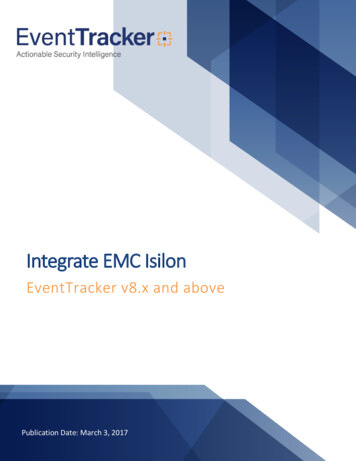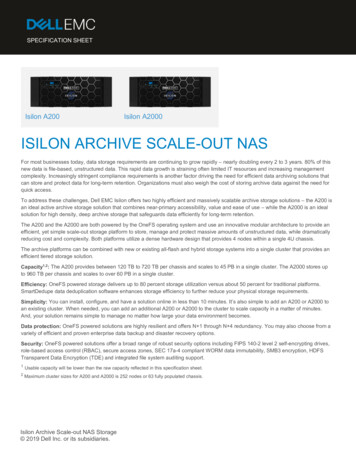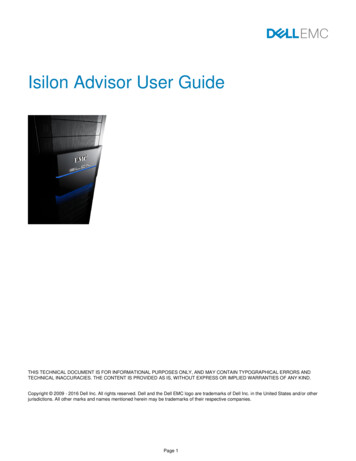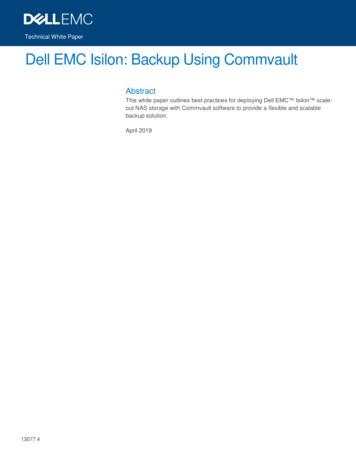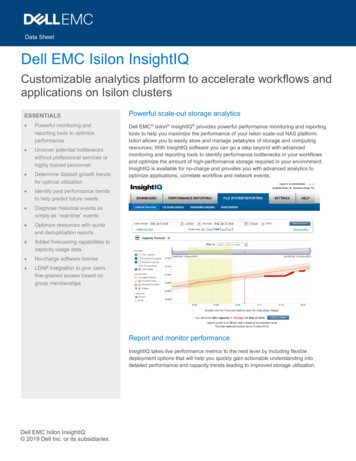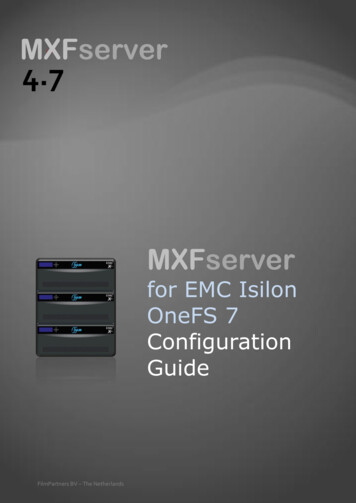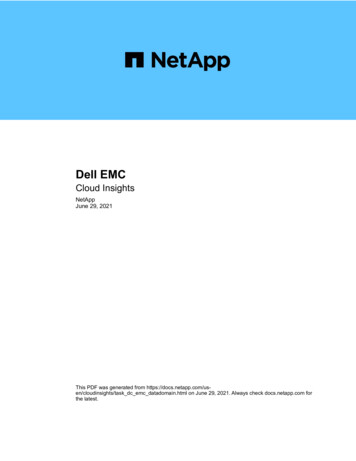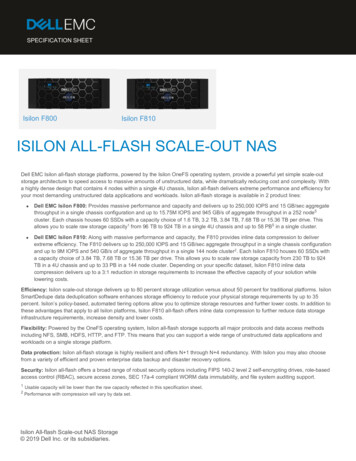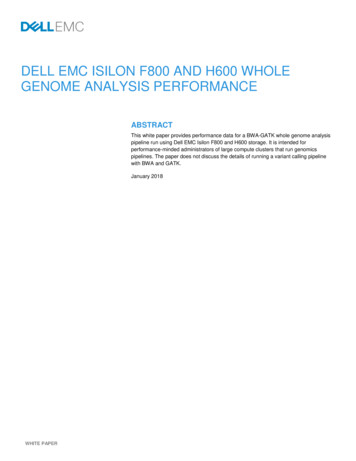
Transcription
DELL EMC ISILON F800 AND H600 WHOLEGENOME ANALYSIS PERFORMANCEABSTRACTThis white paper provides performance data for a BWA-GATK whole genome analysispipeline run using Dell EMC Isilon F800 and H600 storage. It is intended forperformance-minded administrators of large compute clusters that run genomicspipelines. The paper does not discuss the details of running a variant calling pipelinewith BWA and GATK.January 2018WHITE PAPER
The information in this publication is provided “as is.” Dell Inc. makes no representations or warranties of any kind with respect tothe information in this publication, and specifically disclaims implied warranties of merchantability or fitness for a particularpurpose.Use, copying, and distribution of any software described in this publication requires an applicable software license.Copyright 2018 Dell Inc. or its subsidiaries. All Rights Reserved. Dell, EMC, and other trademarks are trademarks of Dell Inc. orits subsidiaries. Other trademarks may be the property of their respective owners. Published in the USA. 1/18 White PaperDell EMC believes the information in this document is accurate as of its publication date. The information is subject to changewithout notice.2
TABLE OF CONTENTSABSTRACT .1EXECUTIVE SUMMARY .4INTRODUCTION .4DELL EMC ISILON .4PERFORMANCE EVALUATION .4STORAGE CONFIGURATIONS . 5COMPUTE NODES. 5NETWORK CONNECTIVITY . 7WHOLE GENOME SEQUENCE VARIANT ANALYSIS . 8SUMMARY . 12REFERENCES . 123
EXECUTIVE SUMMARYThis Dell EMC technical white paper describes whole genome analysis performance results for Dell EMC Isilon F800 and H600 storageclusters (4 Isilon nodes per cluster). The data is intended to inform administrators on the suitability of Isilon storage clusters for highperformance genomic analysis.INTRODUCTIONThe goal of this document is to present an F800 versus an H600 performance comparison, and to compare them to other storageofferings like the Dell HPC Lustre Storage Solution1 for the processing of genomic pipelines. The same test methodologies and thesame test hardware were used where possible to generate the results.DELL EMC ISILONDell EMC Isilon is a proven scale-out network attached storage (NAS) solution that can handle the unstructured data prevalent in manydifferent workflows. The Isilon storage architecture automatically aligns application needs with performance, capacity, and economics.As performance and capacity demands increase, both can be scaled simply and non-disruptively, allowing applications and users tocontinue working.The Dell EMC Isilon storage system features: A high degree of scalability, with grow-as-you-go flexibilityHigh efficiency to reduce costsMulti-protocol support such as SMB, NFS, HTTP and HDFS to maximize operational flexibilityEnterprise data protection and resiliencyRobust security optionsA single Isilon storage cluster can host multiple node types to maximize deployment flexibility. Node types range from the Isilon F (AllFlash) to H (Hybrid), and A (Archive) nodes. Each provides a different optimization point for capacity, performance, and cost.Automated processes can be established that automatically migrate data from higher-performance, higher-cost nodes to more costeffective storage. Nodes can be added “on the fly,” with no disruption of user services. Additional nodes result in increased performance(including network interconnect), capacity and resiliency.The Dell EMC Isilon OneFS operating system powers all Dell EMC Isilon scale-out NAS storage solutions. OneFS also supportsadditional services for performance, security, and protection: SmartConnect is a software module that optimizes performance and availability by enabling intelligent client connection loadbalancing and failover support. Through a single host name, SmartConnect enables client connection load balancing and dynamicNFS failover and failback of client connections across storage nodes to provide optimal utilization of the cluster resources. SmartPools provides rule based movement of data through tiers within an Isilon cluster. Institutions can set up rules keeping thehigher performing nodes available for immediate access to data for computational needs and NL and HD series used for all otherdata. It does all this while keeping data within the same namespace, which can be especially useful in a large shared researchenvironment. SmartFail and Auto Balance ensure that data is protected across the entire cluster. There is no data loss in the event of anyfailure and no rebuild time necessary. This contrasts favorably with other file systems such as Lustre or GPFS as they havesignificant rebuild times and procedures in the event of failure with no guarantee of 100% data recovery. SmartQuotas help control and limit data growth. Evolving data acquisition and analysis modalities coupled with significantmovement and turnover of users can lead to significant consumption of space. Institutions without a comprehensive datamanagement plan or practice can rely on SmartQuotas to better manage growth.Through utilization of common network protocols such as CIFS/SMB, NFS, HDFS, and HTTP, Isilon can be accessed from any numberof machines by any number of users leveraging existing authentication services.PERFORMANCE EVALUATIONThe motivation for this performance analysis was to investigate the ability of the F800 and H600 to support human whole genomevariant calling analysis. The tested pipeline used the Burrows-Wheeler Aligner (BWA) for the alignment step and Genome Analysis Tool4
Kit (GATK) for the variant calling step. These are considered standard tools for aligning and variant calling in whole genome or exomesequencing data analysis.STORAGE CONFIGURATIONSTable 1 lists the configuration details of the three storage systems benchmarked. Default OneFS settings, SmartConnect and NFSv3were used in all the Isilon tests. A development release of OneFS was used on the F800. Upgrading to the same OneFS version asused on the H600 would likely yield slightly better results. The F800 also uses 40GbE as a backend network, compared to the H600which uses QDR Infiniband. OneFS v8.1 has been optimized for use with GbE and performs slightly better than QDR Infiniband.Details on the Dell HPC Lustre Storage Solution used in these tests can be found here2.Table 1. Storage ConfigurationsCOMPUTE NODES64 nodes of the Zenith compute cluster3 were used during the tests. Table 2 lists Zenith compute node configuration details. Thecompute nodes were upgraded from RHEL 7.2 to RHEL 7.3 for the H600 tests.5
DELL HPC INNOVATION LABS ZENITH COMPUTE CLUSTERCompute ClientsProcessorMemoryOperating SystemKernelSystem BIOSProfileNetwork64 x PowerEdge C6320sCPU: Intel(R) Xeon(R) CPU E5-2697 v4 @ 2.30GHzNo. of cores 18 per processor (36 per node)Processor Base Frequency: 2.3GHzAVX Base: 2.0GHz128 GB @ 2400 MHz per nodeRed Hat Enterprise Linux Server release 7.2 (7.3 for H600 tests)3.10.0-327.13.1.el7.x86 64 (3.10.0-514.el7.x86 64 for H600 tests)Max Performance Turbo mode: Enabled C-states: disabled Node interleave: disabled Logical processor: disabled Snoop mode: opportunistic snoop broadcast I/O-Nonposted Prefetch: Disabled1GbE, 10GbE, and Intel OmniPathTable 2. Zenith Compute Cluster Node Configuration Details6
NETWORK CONNECTIVITYThe Zenith cluster and F800 storage system were connected via 8 x 40GbE links. Figure 1 shows the network topology used in thetests. The H600 was configured in the exact same way as the F800. Figure 2 shows the network configuration of the Dell HPC LustreSolution. An OmniPath network was used for the Lustre tests.Figure 1. Network Diagram Of The F800 Benchmark ConfigurationFigure 2. Network Diagram Of The Lustre Benchmark Configuration7
WHOLE GENOME SEQUENCE VARIANT ANALYSISGATK version 3.5 and BWA version 0.7.2-r1039 were used to benchmark variant calling on the Lustre system, while GATK version 3.6was used for runs using the F800 and H600. The whole genome workflow was obtained from the workshop, GATK Best Practices4, andits implementation is detailed here5 and here2. The publicly available human genome data set used for the tests was ERR091571.ERR091571 is one of Illumina’s Platinum Genomes from the NA12878 individual that has been used for benchmarking by manygenome analysis developers, and is relatively error free. The data set can be downloaded from the Short Read Archive (SRA) at theEuropean Bioinformatics Institute here6.To determine the maximum sample throughput possible, an increasing number of genome samples were run on an increasing numberof compute nodes with either 2 or 3 samples being run simultaneously on each node. Batches of 64-189 samples were run on 32-63compute nodes that mounted NFS exported directories from the F800 storage cluster. Figure 3 illustrates the wall-clock time it took foreach step in the pipeline (left axis) as well as total run time, while the right axis is a measure of how many genomes per day can beprocessed utilizing a particular sample size, samples/node ratio and total compute node combination. The samples/node ratio andnumber of compute nodes used per batch of samples is illustrated beneath the graph. For the 64,104 and 126 sample sizes, 32, 52 and63 compute nodes were used, respectively, with a sample/node ratio of 2. For the 129,156,180 and 189 sample sizes, 43, 52, 60 and63 compute nodes were used, respectively, with a sample/node ratio of 3.Figure 3. Number of 10x WGS BWA-GATK performance results on F800. The second 126 sample plot is from a test using 30xgenome samples (122 genomes/day).The benchmark results in Figure 3 illustrate that when running 2 samples/compute node, the total run time is approximately 11.5 hours,while running 3 samples/node yields an approximately 14 hour run time. While the run time is longer when running 3 samples/node thetotal genomes/day throughput is higher, resulting in 325 genomes/day in the run with 189 samples. Genomes/day is calculated like so:(24 hours/total sample run time(hours)) x number of samples number of samples that can be processed in a 24-hour period, i.e.genomes/day. In the case of the 189 sample run, this equates to (24 hours/13.94 hours total run time) x 189 325.4 genomes/day.8
To determine the maximum sample throughput possible while using an H600 for data input and pipeline output, an increasing numberof genome samples were run on an increasing number of compute nodes with either 2 or 3 samples being run simultaneously on eachnode. Batches of 32-192 samples were run on 16-64 compute nodes while using the H600 NFS-mounted to the compute nodes. Figure4 illustrates the wall-clock time for each step in the pipeline on the left axis as well as total run time, while the right axis is a measure ofhow many genomes per day can be processed utilizing a particular sample size, samples/node ration and total compute nodecombination. The samples/node ratio and number of compute nodes used per batch of samples is illustrated beneath the graph. For the32, 64, 80, 92, 116 and 128 sample sizes, 16, 32, 40, 46, 58 and 64 compute nodes were used, respectively, with a sample/node ratioof 2. For the 156 and 192 sample sizes, 52 and 64 compute nodes were used, respectively, with a sample/node ratio of 3. The bestperforming samples/node ratio will change depending on the number of cores and memory available on the nodes.Figure 4. Number 10x WGS BWA-GATK performance results on H600.The benchmark results in Figure 4 illustrate that when running 2 samples/compute node, the total run time is between 11 and 13 hours,while running 3 samples/node yields an approximately 15 hour run time (156 samples). While the run time is longer when running 3samples/node the total genomes/day throughput is higher, resulting in 252 genomes/day in the run with 156 samples. While the F800was able to handle the processing of 189 samples in 14 hours, the H600 could not process 192 samples effectively. The 192 sampletotal run time was over 30 hours (147 genomes/day), a significant performance decrease compared to the 156 sample run (15 hours). If 192 genomes/day is required, then an additional H600 should be added to the cluster. Alternatively, as seen in Figure 3, a singleF800 can provide that level of performance.Comparing maximum pipeline throughput performance between the F800 (325 genomes/day) and the H600 (252 genomes/day) resultsin 73 more genomes/day processed using the F800.9
Figure 5. BWA-GATK performance results comparison between F800 and H600.Plotting genomes/day throughput versus sample size for the F800 and H600 shows that performance on both platforms scales similarlyup to 128 samples (Figure 5). Past that, H600 performance levels off and then deteriorates while F800 performance continues toimprove. Future tests will utilize more than 64 compute nodes in an attempt to maximize pipeline throughput on the F800.We can provide a comparison when running the same genome data set using a Lustre filesystem instead of Isilon. In this case, 80samples were run using 40 compute nodes with 2 samples/node on the Lustre filesystem described in Table 1 2,5. This run configurationwas also completed on the H600 (Figure 4). The total run time and genomes/day results were nearly identical (Figure 6). The runfinished 4 minutes faster on the Lustre system to give it the smallest advantage in calculating genomes/day; H600 164.38, Lustre 165.37. An 80 sample run was not completed using the F800, but if we average the results from the 64 and 104 samples runs, 136 and219 genomes/day, respectively, we arrive at 177 genomes/day for 84 samples ((104 64)/2) on the F800, with an average of 42 nodesused ((32 52)/2) running 2 samples/node. While not the most scientific of interpolations, this inference makes sense given that theH600 and F800 performance scaled similarly up to approximately 128 samples (Figure 5).10
Figure 6. BWA-GATK performance results comparison between H600 and Lustre. The 80* labeled samples were run using aDell HPC Lustre Storage Solution.Isilon storage provides an additional performance advantage when running large numbers of genomic analyses that consume largeamounts of disk space. As can be seen in Figure 7, genomic analysis performance remains consistent whether the H600 is nearlyempty (1% full) or almost completely full (91%). This consistent, scalable performance is critical for projects intent on sequencingthousands or millions of genomes.11
BWA-GATK v3.6 with Isilon H60064 Samples on 32 nodes14140129131134129131132127120Apply Recalibration10100880660Genomes/DayRunning Time (hours)124Variant RecalibrationGenotypeGVCFsHaplotypeCallerBase RecalibrationRealign around InDelGenerate Realigning TargetsMark/Remove Duplicates402Aligning & SortingNumber of Genomes per Day0201%14%19%37%55%73%91%Storage Usage: % fullFigure 7. BWA-GATK performance results on H600 as storage usage increases.SUMMARYThe results in this paper demonstrate that running whole genome analyses on the F800 and H600 platforms scales predictably and thatboth are capable of supporting hundreds of simultaneous whole genome analyses in a single day. The F800 performs slightly betterwith low sample workloads and much better with higher sample workloads than the H600, so the F800 is recommended for the highestthroughput environments.If the HPC environment is exclusively for processing genomic analyses, then both Isilon and Lustre are good choices, but Isilon is abetter choice if features like backup, snapshots and multiple protocol (SMB/NFS/HDFS) support are required. If Isilon is chosen, thengiven the results in this paper, a rough genomes/day calculation can be made in order to choose between the F800 or H600. However,if the HPC workload is mixed and includes MPI-based or other applications that require low latency interconnects (Infiniband orOmniPath) in order to scale well, then Lustre is the better choice.REFERENCES1. Dell HPC Lustre Storage Solution: Dell HPC Lustre Storage with IEEL 3.02. Dell EMC HPC System for Life Sciences v1.1 (January 2017)3. All benchmark tests were run on the Zenith cluster in the Dell HPC Innovation Lab in Round Rock, TX. Zenith ranked #292 in theTop 500 ranking as of November 2017: https://top500.org/list/2017/11/?page 34. GATK Best Practices ctices/; Accessed 1/24/2018)5. Variant Calling Benchmark – Not Only Human iant-calling-benchmark-not-only-human; Accessed 1/24/2018)6. Human genome 10x coverage data set 1/ERR091571/; Accessed 1/24/2018)12
The Dell EMC Isilon OneFS operating system powers all Dell EMC Isilon scale-out NAS storage solutions. OneFS also supports additional services for performance, security, and protection: SmartConnect is a software module that optimizes performance and availability by enabling intelligent client connection load balancing and failover support.
